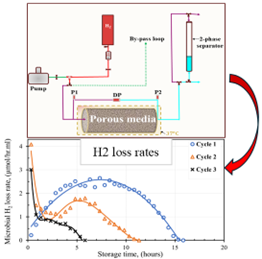Experimental Study of Microbial Hydrogen Consumption Rates by Oleidesulfovibrio Alaskensis in Porous Media
“Experimental Study of Microbial Hydrogen Consumption Rates by Oleidesulfovibrio Alaskensis in Porous Media” by Raymond Mushabe, Na Liu, Nicole Dopffel, Geir Ersland, Martin A. Fernø
Developed an experimental procedure to conduct anaerobic microbial hydrogen consumption tests in sand pack columns as reservoir rock analogues.
We used a well-studied sulphate reducer, Oleidesulfovibrio alaskensis G2 0as a model bacterium strain A.
Repeated drainage and storage scenarios were developed, and microbial hydrogen consumption rates were determined depicting a worst-case scenario in a nutrient rich reservoir environment. Here are the key study findings:
- We observed an exponential decay in microbial hydrogen consumption between storage cycles.
- Maximum microbial activity occurred 2 - 5 hours after hydrogen injection, with consumption peaking at 1.26 ± 0.12 µmol/hr/ml on average in the first cycle.
- Hydrogen consumption rates in sand packs were 1 - 2 orders of magnitude higher than those observed in batch tests. Attributed to greater fluid interfaces area in porous media.
- Observed improvement in the average hydrogen in place saturations after the first non-sterile storage cycles (4 - 24 ± 1.4%) through repeated drainage tests.
- In the absence of pH buffering, the microbial risk due to the studied sulphate reducer was limited by brine pH increase.
- No signifcant reservoir damage with respect to porosity and permeability due to bacteria growth, and no substantial pressure effect on consumption rates
Our experimental data contributes to the understanding of microbial hydrogen loss risk during UHS and how it can affect recovery and storage efficiency.
Read the full article in InterPore Journal here: https://doi.org/10.69631/ipj.v2i2nr72

